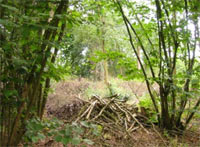- Sell Your Woodland
- Woodland for Sale
- East of England
- East Midlands
- West Midlands
- North East England
- North West England
- South East England
- South West England
- Woodland for Sale Yorkshire
- Woodland for Sale N. Ireland
- Woodland for Sale Scotland
- Woodland for Sale Wales
- Woodland Information
- Testimonials
- Woodland News
- Woodland buyers guide
- Buying woodland for sale
- Woodland Uses
- Investing in woodland
- Types of Woodland
- Resources
- Glossary
- Home Page
Woodland from Vantage Land
Woodland for sale throughout the UK. Call 01727 701641 for current availability in your area.
Coppicing
 Traditionally woodlands are managed via the coppicing - young tree stems are cut down to a low level, or sometimes right down to the ground. Over the following years new shoots emerge, once mature the wood is harvested and the cycle begins again. The area of woodland coppiced is rotated to provided an annual crop as well as providing a diverse environment with a range of different aged stools growing in it.
Traditionally woodlands are managed via the coppicing - young tree stems are cut down to a low level, or sometimes right down to the ground. Over the following years new shoots emerge, once mature the wood is harvested and the cycle begins again. The area of woodland coppiced is rotated to provided an annual crop as well as providing a diverse environment with a range of different aged stools growing in it.
The cycle length depends upon the species and the intended use. Birch can be coppiced for faggots on a 3- or 4-year cycle, whereas oak can be coppiced over a 50-year cycle for poles or firewood - willow, hazel and sweet chesnut are popular coppice trees in the UK.
Shoots of young willow may be used for interweaving in wattle fencing, hardwoods such as oak or ash may be left to provide long straight poles. Specific growth patterns can be encouraged with coppicing as found with cinnamon trees which are grown for their bark.
In the past coppiced wood would be used for for many purposes, such as charcoal, but only a minority of these woods are still operated for coppice today operating for woodland crafts. The only remaining large-scale commercial coppice crop in the area is sweet chestnut which is grown in parts of East Sussex and Kent for splitting and binding into cleft chestnut paling fence bound together with wire.
